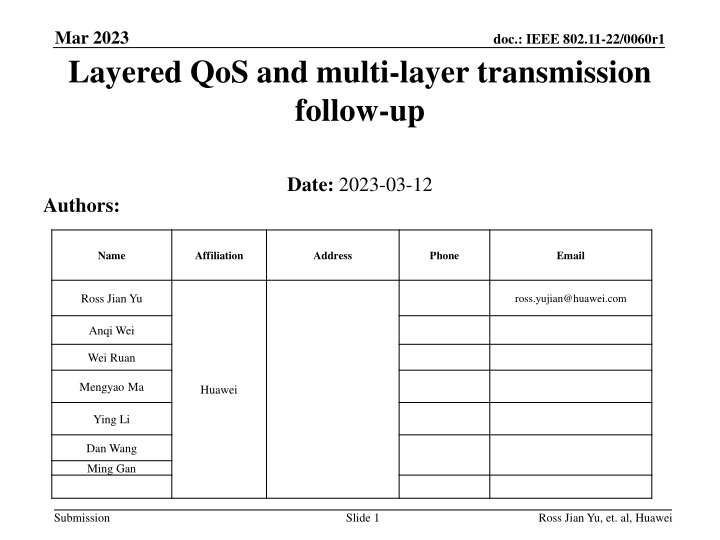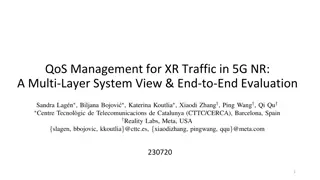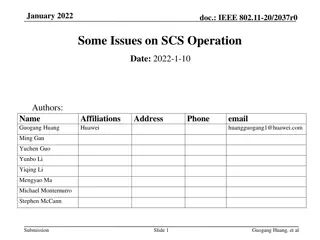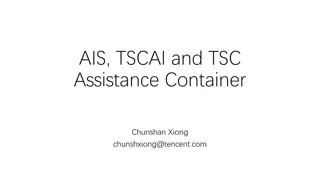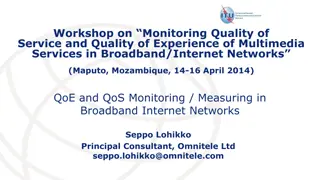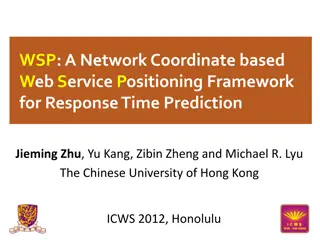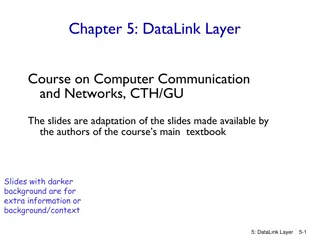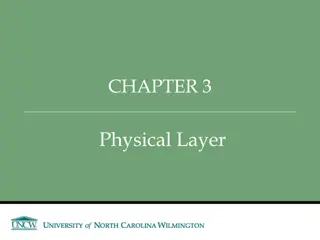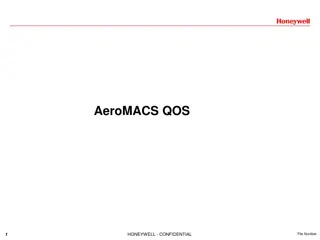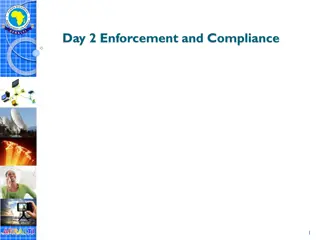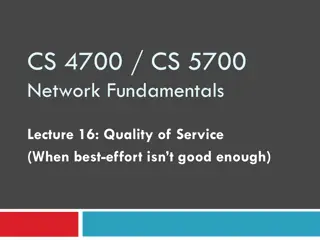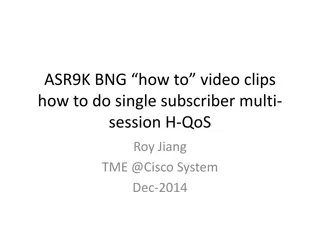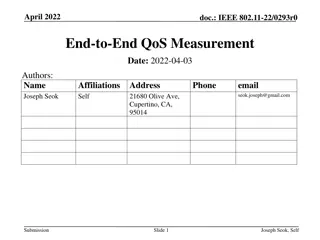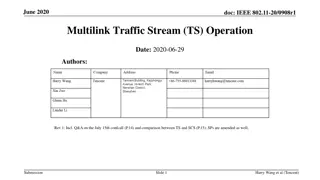Layered QoS & Multi-Layer Transmission in IEEE 802.11-22
Detailed exploration of Layered QoS & Multi-Layer Transmission in IEEE 802.11-22 standard, focusing on benefits like different protections for data frames, channel selective gains, performance comparisons, and simulation results in interference environments.
Download Presentation

Please find below an Image/Link to download the presentation.
The content on the website is provided AS IS for your information and personal use only. It may not be sold, licensed, or shared on other websites without obtaining consent from the author.If you encounter any issues during the download, it is possible that the publisher has removed the file from their server.
You are allowed to download the files provided on this website for personal or commercial use, subject to the condition that they are used lawfully. All files are the property of their respective owners.
The content on the website is provided AS IS for your information and personal use only. It may not be sold, licensed, or shared on other websites without obtaining consent from the author.
E N D
Presentation Transcript
Mar 2023 doc.: IEEE 802.11-22/0060r1 Layered QoS and multi-layer transmission follow-up Date: 2023-03-12 Authors: Name Affiliation Address Phone Email Ross Jian Yu ross.yujian@huawei.com Anqi Wei Wei Ruan Mengyao Ma Huawei Ying Li Dan Wang Ming Gan Submission Slide 1 Ross Jian Yu, et. al, Huawei
Mar 2023 doc.: IEEE 802.11-22/0060r1 Recap In [3], a detailed description on cloud VR use case have been presented, which needs high requirement on Tput and latency. Moreover, two aspects regarding latency reduction have been presented: QoS enhancement Unequal error protection (multi-layer/coding transmission) In [1], we show multi-layer transmission has the following benefits: Provide different protections for frames of different importance. Take advantage of the channel selective gains Good for interference environment, errors happened in one RU layer doesn t affect the other RU. There were some comments received regarding the simulation results we show for MC (Multiple Coding)-MIMO vs SU-MIMO. In this contribution, further simulation results are provided in response to those comments. Simulation results for an interference environment are also provided. Submission Slide 2 Ross Jian Yu, et. al, Huawei
Mar 2023 doc.: IEEE 802.11-22/0060r1 Simulation setup MC-MIMO vs SU- MIMO In previous simulations, we show the comparison of 4Tx, 4Rx, 4SS transmission between MC (Multiple Coding)-MIMO vs SU-MIMO where MC code can apply different MCS on different streams. Different PSDU are transmitted in different streams. The MC-MIMO shows at least 10%~15% gain over SU-MIMO. We receive the following comments regarding the simulations: For baseline SU-MIMO, 3SS sometimes can achieve higher Tput than 4SS for a 4Tx, 4Rx transmission. With unequal power allocation (waterfilling), the baseline SU MIMO can achieve better performance. Hence in this simulation, we compare the following four cases: MC-MIMO SU-MIMO 4SS (with equal power) SU-MIMO 3SS (with equal power) SU MIMO 4SS with unequal power* SU MIMO 3SS with unequal power* Other parameters are the same as before: 4 Tx and 4 Rx, 20MHz channel *With unequal power allocation, the transmit power imbalance of each antenna increases. The power of some RF chan nels may exceeds a preset value, and the power of some channels is not fully used. Submission Slide 3 Ross Jian Yu, et. al, Huawei
Mar 2023 Simulation results MC-MIMO vs SU- MIMO doc.: IEEE 802.11-22/0060r1 X-axis: channel SNR, Y-axis: Tput MC-MIMO still shows obvious gain over baseline SU-MIMO. Submission Slide 4 Ross Jian Yu, et. al, Huawei
Mar 2023 doc.: IEEE 802.11-22/0060r1 Simulation setup Independent coding MRU vs joint coding RU/MRU Simulation results for interference environment are also provided. The total bandwidth is 80 MHz, AWGN channel. The Power RSSI is -50dBm. The interference is added to the upper 40 MHz (defined as RU 1). The interference occupies 50% and 90% of the total time respectively. Three cases are compared: SU case: joint coding over the whole bandwidth, following the current procedure SU Punc case: joint coding over the non-interfered potion of the total bandwidth (lower 40 MHz, defined as RU 0). More accurately, this is a smaller bandwidth transmission. MRU case: independent coding MRU case, the data is encoded separately in RU 0 and RU1. 1T1R. Throughput is optimized regarding all supported MCSs. Upper 40 MHz, RU 1 Interference Lower 40 MHz, RU 0 Submission Slide 5 Ross Jian Yu, et. al, Huawei
Mar 2023 doc.: IEEE 802.11-22/0060r1 Simulation results Independent coding MRU vs joint coding RU/MRU Independent coding MRU case shows obvious throughput gain compared with single coding RU case. Submission Slide 6 Ross Jian Yu, et. al, Huawei
Mar 2023 doc.: IEEE 802.11-22/0060r1 Simulation results Independent coding MRU vs joint coding RU/MRU Independent coding MRU case shows obvious throughput gain compared with single coding RU case. Submission Slide 7 Ross Jian Yu, et. al, Huawei
Mar 2023 doc.: IEEE 802.11-22/0060r1 Summary In this contribution, we show more simulation results to show the benefits of multi-layer transmission regarding two aspects: Multi-layer over spatial domain: taking advantage of the channel selective gain Multi-layer over frequency domain: Tput gain in interference scenario. Submission Slide 8 Ross Jian Yu, et. al, Huawei
Mar 2023 doc.: IEEE 802.11-22/0060r1 Reference [1] 11-22/1930r0, Layered QoS and multi-layer transmission [2] 11-22/1518r0, 802.11 UHR SG Proposed PAR, Ming Gan et.al., Huawei [3] 11-22/0952r0, Cloud VR use case and requirements, Ross Jian Yu et.al., Huawei Submission Slide 9 Ross Jian Yu, et. al, Huawei
Mar 2023 doc.: IEEE 802.11-22/0060r1 Appendix Submission Slide 10 Ross Jian Yu, et. al, Huawei
Mar 2023 doc.: IEEE 802.11-22/0060r1 Multi-layer transmission In [2], it mentions multi-layer transmission is one kind of unequal error protection at PHY layer that can provide different robustness to different services. The base layer (I frame) is protected better with lower rate whilst the enhancement layer (P/B frame) is protected with higher rate. Multi-layer transmission can achieve a good tradeoff between data rate and robustness. It can further reduce transmission latency. One way of enabling unequal error protection (UEP) is to use different MCS for different frames in different PPDUs (time domain). An alternative way is to enable multiple PSDUs with different MCS within one PPDU. I frame Other frame Control Info P/B frame PHY PHY PHY PHY In different SSs/RUs/ Constellation points Resources Resources Resources Resources Multi-layer transmission (QAM, coding rate, NSS, ReTx times) PPDU Submission Slide 11 Ross Jian Yu, et. al, Huawei
Mar 2023 doc.: IEEE 802.11-22/0060r1 Multi-layer transmission Besides UEP for frames of different importance, multi-layer transmission can also take good advantage of the channel selective gain (e.g., divergence of eigenvalues between different spatial streams). In 11n, UEQM (unequal modulation) MIMO enables different QAMs for different streams with the same coding rate. Here, we further assume coding rate can also be different. Below is an example. Tput/ MCS Figure: MC (Multiple Coding)-MIMO vs SU-MIMO Legend MCS11 vs MCS6 Post SNR Tput of SSx for MC- MIM O Tput of SSx for SU- MIM O MCS10 vs MCS6 P o s t S N R S S 0 MCS9 vs MCS6 P o s t S N R S S 1 MCS6 vs MCS6 P o s t S N R S S 2 S S 0 S S 1 S S 2 P o s t S N R S S 3 S S 3 PostSNR Submission Slide 12 Ross Jian Yu, et. al, Huawei
Mar 2023 doc.: IEEE 802.11-22/0060r1 Multi-layer transmission Below we show some simulation results comparing MC-MIMO and SU- MIMO. 4 Tx and 4 Rx and a 4SS MIMO, 20MHz channel. X-axis: channel SNR, Y-axis: Tput MC-MIMO has 10%~15% gain over baseline SU-MIMO. (a) Channel B (b) Shielding room (c) Home environment Submission Slide 13 Ross Jian Yu, et. al, Huawei
Mar 2023 doc.: IEEE 802.11-22/0060r1 Multi-layer transmission Below we also show some simulation results comparing MC-MIMO and SU-MIMO regarding different directions. 2 Tx and 2 Rx and a 2/1 SS MIMO, 20MHz channel. Tput regarding different directions are compared (omni-direction antennas) Submission Slide 14 Ross Jian Yu, et. al, Huawei
